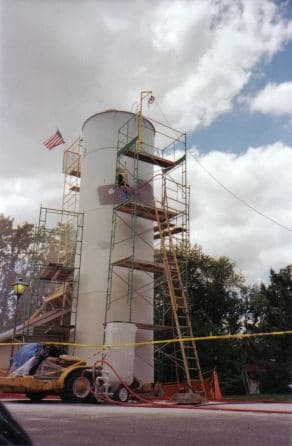
-----
Condensation And Sandblasting Don't Mix
I am often asked to sandblast and paint the exterior of steel potable water storage tanks that are in use, which causes them to sweat do to condensation.If the tank can not be taken off line to allow the water inside to warm or the tank can not be emptied,how can this be done with condensation present? I'm in the eastern United States, where warm weather is accompanied by humidity when the temperature is suitable for exterior painting.
Herb Snydersandblasting company - Shen. Jct., WV, USA
2005
There are a couple of possibilities here; however, I have a couple of questions. Are these tanks all the same size? What size are they? Do they have more than one opening? Basically, I am talking about air flow, temperature and/or possible chemicals.

AF Kenton
retired business owner - Hatboro, Pennsylvania
2005
Mr. Kenton,
Tanks vary in size, average would be a 20,000 gal.water storage standpipe, 10 ft diameter and 34 ft tall. Steel tank has one 24 in sealed manway near tank base, One 24 in covered manway on top. Tank is full within 1 ft. of top. Cold water is pumped from nearby wells into the tank for storage.Water is moving through the tank 24 hr per day as the water utilities requires. Average water temp. in the tank might be 30 or even 40 °F below the air temp. outside. Thus condensation forms on the outside of the tank, from humidity in the air, on most days. The tank can not be taken out of service. There are no chemical being used except the new primer and paint to be applied. I don't know of a water base paint that is suitable. And if one was available, the blasted steel will rust in less than an hour. Surface blasted to SSPS 10 spec.

THANKS
Herb SnyderSandblasting contractor - Shenandoah Jct., West Virginia, USA
2005
Hmmmm. Big SOB and not an easy problem. This is a little out of my area of knowledge, but I suggest you contact a major paint manufacturer and ask for their technical dept. It is possible you are going to end up with some type of an epoxy 2 part system or something that will react with the metal. It is not a problem that can be solved mechanically.

AF Kenton
retired business owner - Hatboro, Pennsylvania
2005
The thing that seems out of the ordinary to me is why the owners of the tanks would want you to completely remove the original finish, there usually isn't anything as good as the original finish and if you prep it right it should be useable a primer,(maybe they need to be educated) then you can repaint without removing it. I'll bet you could even stay ahead of the condensation that way. That would be more of an ideal situation. However, you didn't say what kind of condition the tanks are in now, is there a lot of rust bubbling under the surface of the existing paint? If there is, you could remove the paint only where the rust is, repair it and prime it, it sure would make things a lot less complicated. There isn't any way that I would ever consider sand blasting a job like this, obviously it's going to have to be done in sections, and in a high humidity situation you hit the nail on the head about the sand blasted surface rusting almost immediatly. Just a side note, you can use faster drying reducers in your paints when the whether is colder and less humid, so you shouldn't be limited to hotter days in order to paint.

Sheldon Taylor
supply chain electronics
Wake Forest, North Carolina
2005
Not my field either but here's an exotic idea. If you set up kind of a curtain or plastic blind around the tank and seal it as much as possible, instal a portable air conditioner suited to blow as much cold air as possible to produce an inside temperature similar to the water in the tank, you stop condensation and your blasting and painting job can proceed. I said it was an exotic idea didn't I... but it works theoretically.
Guillermo MarrufoMonterrey, NL, Mexico
2005
Q, A, or Comment on THIS thread -or- Start a NEW Thread